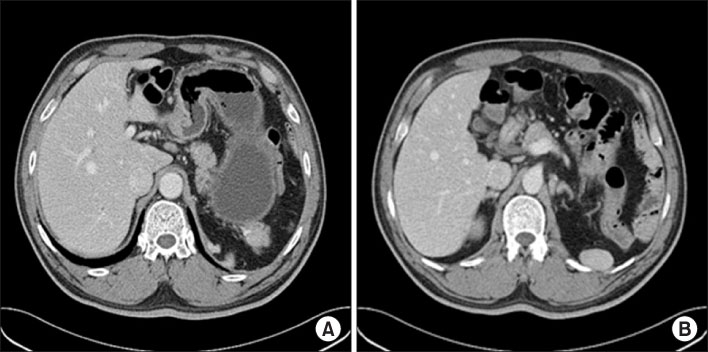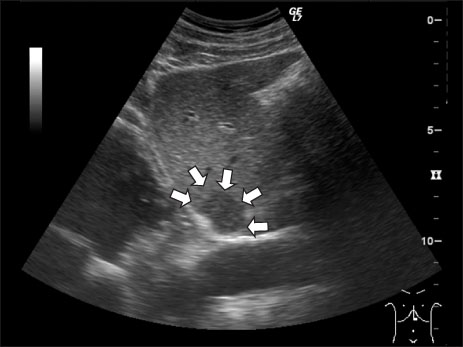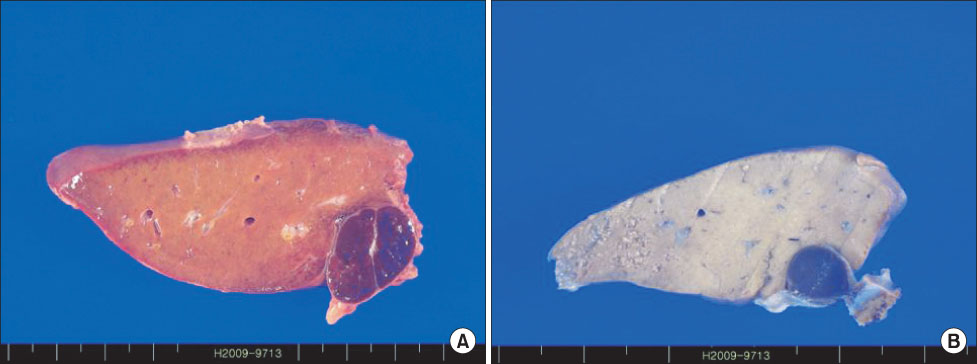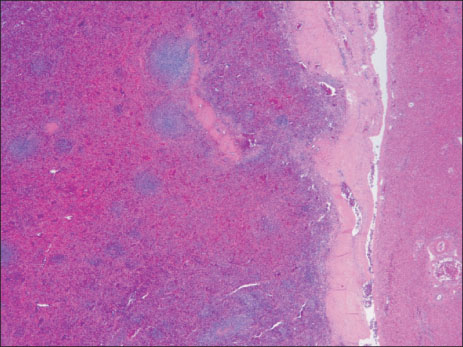J Gastric Cancer.
2011 Mar;11(1):64-68.
Intrahepatic Splenosis Mimicking Liver Metastasis in a Patient with Gastric Cancer
- Affiliations
-
- 1Department of Surgery, Soonchunhyang University College of Medicine, Bucheon, Korea. gschogs@schbc.ac.kr
- 2Department of Pathology, Soonchunhyang University College of Medicine, Bucheon, Korea.
- 3Department of Radiology, Soonchunhyang University College of Medicine, Bucheon, Korea.
Abstract
- A 54 year old man was referred to our hospital with gastric cancer. The patient had a history of splenectomy and a left nephrectomy as a result of a traffic accident 15 years earlier. The endoscopic findings were advanced gastric cancer at the lower body of the stomach. Abdominal ultrasonography (USG) and magnetic resonance imaging demonstrated a metastatic nodule in the S2 segment of the liver. Eventually, the clinical stage was determined to be cT2cN1cM1 and a radical distal gastrectomy, lateral segmentectomy of the liver were performed. The histopathology findings confirmed the diagnosis of intrahepatic splenosis, omental splenosis. Hepatic splenosis is not rare in patients with a history of splenic trauma or splenectomy. Nevertheless, this is the first report describing a patient with gastric cancer and intrahepatic splenosis that was misinterpreted as a liver metastatic nodule. Intra-operative USG guided fine needle aspiration should be considered to avoid unnecessary liver resections in patients with a suspicious hepatic metastasis.
Keyword
MeSH Terms
Figure
Reference
-
1. Shaw AFB, Shafi A. Traumatic autoplastic transplantation of splenic tissue in man with observations on the late results of splenectomy in six cases. J Pathol. 1937. 45:215–235.
Article2. Fleming CR, Dickson ER, Harrison EG Jr. Splenosis: autotransplantation of splenic tissue. Am J Med. 1976. 61:414–419.
Article3. Marchant LK, Levine MS, Furth EE. Splenic implant in the jejunum: radiographic and pathologic findings. Abdom Imaging. 1995. 20:518–520.
Article4. Bock DB, King BF, Hezmall HP, Oesterling JE. Splenosis presenting as a left renal mass indistinguishable from renal cell carcinoma. J Urol. 1991. 146:152–154.
Article5. De Vuysere S, Van Steenbergen W, Aerts R, Van Hauwaert H, Van Beckevoort D, Van Hoe L. Intrahepatic splenosis: imaging features. Abdom Imaging. 2000. 25:187–189.
Article6. Stein S, Duarte PS, Alavi A, Zhuang H, Alavi JB. Multiple intraabdominal soft-tissue masses in a man awaiting liver transplantation: a case study and discussion. Am J Clin Oncol. 2000. 23:506–508.
Article7. Lee JB, Ryu KW, Song TJ, Suh SO, Kim YC, Koo BH, et al. Hepatic splenosis diagnosed as hepatocellular carcinoma: report of a case. Surg Today. 2002. 32:180–182.
Article8. D'Angelica M, Fong Y, Blumgart LH. Isolated hepatic splenosis: first reported case. HPB Surg. 1998. 11:39–42.9. Kondo M, Okazaki H, Takai K, Nishikawa J, Ohta H, Uekusa T, et al. Intrahepatic splenosis in a patient with chronic hepatitis C. J Gastroenterol. 2004. 39:1013–1015.
Article10. Abu Hilal M, Harb A, Zeidan B, Steadman B, Primrose JN, Pearce NW. Hepatic splenosis mimicking HCC in a patient with hepatitis C liver cirrhosis and mildly raised alpha feto protein; the important role of explorative laparoscopy. World J Surg Oncol. 2009. 7:1.
Article11. Nakajima T, Fujiwara A, Yamaguchi M, Makiyama A, Wakae T, Fujita K, et al. Intrahepatic splenosis with severe iron deposition presenting with atypical magnetic resonance images. Intern Med. 2008. 47:743–746.
Article12. Foroudi F, Ahern V, Peduto A. Splenosis mimicking metastases from breast carcinoma. Clin Oncol (R Coll Radiol). 1999. 11:190–192.
Article13. Shirabe K, Shimada M, Matsumata T, Higashi H, Yakeishi Y, Wakiyama S, et al. Analysis of the prognostic factors for liver metastasis of gastric cancer after hepatic resection: a multi-institutional study of the indications for resection. Hepatogastroenterology. 2003. 50:1560–1563.14. Lin WC, Lee RC, Chiang JH, Wei CJ, Chu LS, Liu RS, et al. MR features of abdominal splenosis. AJR Am J Roentgenol. 2003. 180:493–496.
Article15. Hagman TF, Winer-Muram HT, Meyer CA, Jennings SG. Intrathoracic splenosis: superiority of technetium Tc 99m heat-damaged RBC imaging. Chest. 2001. 120:2097–2098.
- Full Text Links
- Actions
-
Cited
- CITED
-
- Close
- Share
- Similar articles
-
- Intrahepatic Splenosis Mimicking Hepatocellular Carcinoma: A Case Report
- Splenosis Mimicking Carcinomatosis Peritonei in Advanced Gastric Cancer
- Splenosis Mimicking Recurrence of Renal Cell Carcinoma after Radical Nephrectomy: A Case Report
- Splenosis Mimicking Hepatocellular Carcinoma
- Hepatic Solitary Metastasis of Gastric Cancer: Radiofrequency






